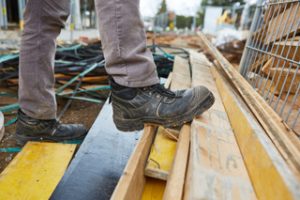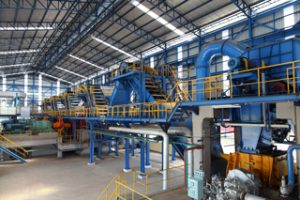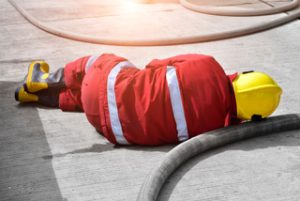This blog originally appeared on the Training ABC website. It is reprinted with permission.
Every year slips, trips, and falls (STFs) cost US businesses 11 billion dollars in workers’ compensation claims, loss of productivity, absences, and regulatory fines. An employee suffering from an STF incident misses an average of 11 workdays, costing millions of dollars to organizations.
OSHA’s Surfaces Standard specifically requires employers to keep all walking-working surfaces clean, dry, and free of hazardous conditions. Due to the physical demands on construction and industrial workers, organizations need to train employees on how to recognize STF hazards and prevent them in the workplace.
What Causes Slips, Trips, and Falls?
Construction and industrial facilities are busy environments with many different STF hazards. The following are the most common causes of STFs in these facilities.
- Floor contaminants such as water, grease, and other fluids that make walking surfaces slippery.
- Dry product spills such as dusts, powders, metal shavings, granules and loose earth also cause slipping hazards.
- Sloped or uneven walking surfaces and loose, irregular surfaces such as gravel, and shifting tiles.
- Mounting and dismounting vehicles and equipment.
- Falls from ladders, scaffolds, stairs, buildings, docks, and other structures.
- Indoor walking surface irregularities such as metal grates, damaged, warped, buckled, or uneven flooring, and rumpled carpeting and mats.
- Outdoor walking surface irregularities like protruding structures, holes, rocks, and other debris.
- Weather conditions creating ice and snow that accumulate near entrances, parking garages, walkways and outside stairs.
- Inadequate lighting such as burned out light bulbs or poorly lit areas that impair vision and the ability to see hazards.
- Uncovered hoses, loose cords, waste materials, plastic wrapping, tools, and other clutter that creates tripping hazards in hallways, walkways and work areas.
- Shoes worn that are not slip-resistant, have worn-down tread, or are clogged with dirt, food, debris, or snow.
How to Prevent Slips, Trips and Falls
This program provides construction and industrial workers ways to reduce and prevent STFs that involve:
- Clutter and Obstructions
- Mats and Rugs
- Housekeeping Procedures
- Wet Surfaces
- Walking Surfaces
- Weather
- Lighting
- Stairs and Elevation Changes
- Employee Falls
- Falling Objects
- Fall Protection
- Scaffolds
- Ladders
- Training and Personal Protective Equipment (PPE)
- General Protocol
This program addresses OSHA regulated STF standards on same level surfaces but also includes fall protection from ladders, scaffolds, and open-sided surfaces.
Falls from elevation will be detailed in a specialized fall protection program.
Clutter and Obstructions
- To reduce STFs, remove clutter and keep exits, aisles, stairs and walkways in good repair and free of obstruction.
- Reroute, cover or bundle exposed cords with protective tape or a cord organizer so cords don’t run across pathways. Mount cords under desks or on equipment.
- Arrange equipment and furniture so that it doesn’t interfere with walkways or foot traffic.
Mats and Rugs
- To prevent STFs, use water absorbent and slip-resistant mats in wet areas where water, grease or other fluids may drip onto the floor.
- Straighten or stretch mats or carpets that bulge or have become bunched to prevent tripping hazards.
- Make sure mats are slip-resistant to prevent mats from moving and creating another hazard.
- Replace mats when they become worn, ripped or curled. Tape down edges if needed.
Housekeeping Procedures

- Mark and immediately clean up all spills including dry products.
- Notify employees of housekeeping procedures and provide contact information for housekeeping via email, posters, and bulletin boards.
- Implement no-skid waxes to create non-slip surfaces in otherwise slippery areas.
- Clean one side of passageways at a time to minimize hazards.
- Utilize caution signs to warn employees and visitors of contaminated areas and remove them when the floor is clean and dry.
- Use caution tape and barriers to prevent entry into wet areas during the cleaning and waxing of floors.
- For grease or oil on the floor, spread vermiculite, kitty litter or another absorbent over the area.
- Sweep everything up and dispose of it properly.
Wet Surfaces
- Maintain proper drainage when wet processes are used.
- Staff working in continually wet environments can reduce accidents by wearing slip-resistant shoes.
- Maintain drip trays under machinery, as well as ice machines and food carts to prevent spills onto the floor.
- Use anti-skid adhesive tape in slippery, high risk, high traffic areas such as bathrooms and kitchens.
Walking Surfaces
- Inspect, straighten, and repair indented, uneven surfaces.
- Replace loose flooring and maintain in a safe condition.
- If correction or repair cannot be made immediately, guard the hazard until corrected.
- Patch, fill, or repave outdoor walking surfaces that have deep grooves, cracks, or holes.
- Repairing any structural integrity requires a licensed a professional to supervise or perform the job.
- Don’t carry loads that obstruct your view.
- When carrying a load, make sure each walking-working surface can support the maximum intended load.
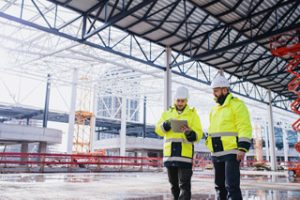
When you must walk on surfaces that could cause an STF:
- Slow down to a pace suitable to the task on that surface, paying close attention to potential obstacles.
- Be careful when transitioning from one surface to another.
- Avoid sharp movements, take short steps, and walk with your feet pointed slightly outward to maintain your center of gravity.
- Use handrails or other stable objects available for support.
- Do not walk with your hands in your pockets.
- Wear slip-resistant footwear.
Weather
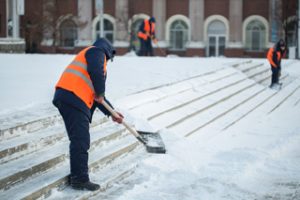
- In areas where applicable, make sure snow removal is appropriately scheduled and email staff of winter weather warnings.
- Place labeled containers with ice melting chemicals and scoops to use in close proximity to icy areas.
- Secure and place these containers in high traffic pedestrian areas like parking garage entrances and exits, the top and bottom of outdoor stairways, and facility entrances.
- Label containers with the appropriate Safety Data Sheets (SDS) and include instructions for handling ice-melting chemicals.
- Make sure ice-melting chemicals are cleared away once walkways are dry.
Lighting
Replace light bulbs when they are out and keep areas sufficiently lit for the tasks performed there.
- Use a flashlight when entering a dark room where there is no light and keep it in a central location in case of a power outage.
- In poorly lit areas, furnish more light fixtures that emit light from all sides. Make sure light bulbs have adequate brightness.
- Make sure proper lighting exists in all halls and stairwells so that unsafe conditions may be recognized.
Stairs and Elevation Changes

- Employers should provide handrails on all stairs, ramps and slopes.
- Always use handrails on stairs, reduce speed, and keep an unobstructed view of each step.
- Repair or replace indoor and outdoor stairs or handrail that are loose or broken.
- Ensure that all stairs are slip resistant and free of ice, snow, water, and other slippery hazards.
- Curbs, ramps, single steps and even cracks in walkways can be hazards. To reduce accidents caused by these hazards: use the stairs instead of jumping off landings or loading docks.
- Place signs or mark changes in elevation with caution tape and paint curbs and steps yellow to warn walkers.
- For a temporary change in elevation, use barricades to create an alternative route to avoid the hazard.
Employee Falls
If you fall, minimize fall injuries by:
- Bending your elbows and knees, protecting your head with your arms.
- Roll in the direction of the fall and don’t try to break the fall with your hands.
- Try to land on your side as it is safer than the back.
Falling Objects
Provide appropriate head protection for employees who may be exposed to falling objects. Employers must protect employees from falling objects by applying one or more of the following safety precautions: Constructing guardrails, canopy structures, toe boards, and screens to prevent objects from falling to a lower level. In addition, keep tools and other objects far enough from an opening to stop them from falling to a lower level and barricade and prohibit employees from entering dangerous areas.
Fall Protection
OSHA mandates fall protection standards for any employee on a walking-working surface with an unprotected side or edge at the elevated height level required for their industry. The General Industry Standard is four feet or higher above a lower level while construction is six feet. Organizations must know their standard and provide fall protection.
Personal fall protection systems are required for General Industry employers and include all components used to prevent or arrest an employee’s fall. Examples of personal fall protection systems include personal fall arrest systems (PFAs), positioning systems, and travel restraint systems. A PFAS is a design system that arrests a fall before a worker makes contact with a lower level. A PFAS has a body harness, anchorage and connector and may also have a lanyard deceleration device, lifeline or appropriate combination.
Employers have many options to customize their fall protection approach and may choose the one best suited to the interests of their employees. A guardrail system provides a barrier along an unprotected or exposed side edge or other area of a walking-working surface to stop workers from falling to a lower level. Other means of fall protection that may be required on certain jobs include a safety harness and line, safety nets, stair railings and handrails.
Prohibit workers from using body belts as part of a personal fall protection system as they are not intended for protection from falls.
OSHA mandates fall protection requirements for numerous work environments such as scaffoldings, repair pits, hoist areas, and open-sided walls, floors and ladderways among others. Open-sided walls, floors, ladderways or platforms with a four foot drop must be guarded by either a standard rail and toe board, roller, picket fence, swinging gate, equivalent barrier or person unless it’s an entrance to a ramp, stairway, or fixed ladder.
Regardless of height, provide railing with a toe board for moving machinery adjacent or beneath the open sides where falling materials create a hazard to passing people. Where operating conditions require the feeding of material into a hatchway or chute opening, provide protection to prevent a person from falling through that opening. Guard every infrequently used pit, trapdoor and temporary floor opening with a standard cover, attendant or standard removable railings on all exposed sides.
Scaffolds
To protect employees from STFs on scaffolds, install guardrail systems along all open sides and ends of platforms as required by OSHA.
- Scaffolds must only be erected by trained individuals known as erectors.
- A competent person must inspect scaffolds on a daily basis and tag them appropriately.
- For scaffolds, the OSHA standard requires employers to provide appropriate fall protection when 10 feet above a lower level.
- Provide safe scaffold platform access when more than two feet above or below a point of access.
Direct access is permissible when the scaffold is not more than 14 inches horizontally and not more than 24 inches vertically from other surfaces. To prevent a fall, never climb on a scaffold’s cross bracing.
Ladders
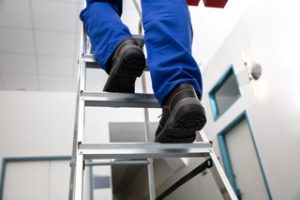
- Use only properly maintained, OSHA compliant ladders that meet the weight requirements for the work being performed.
- Refrain from using stools, chairs, or boxes as substitutes.
- Place ladders on firm, level surfaces and maintain three-point contact when climbing or descending.
- Keep two hands and one foot or two feet and one hand on the ladder at all times, known as three points of contact. Maintain until you reach the ground or a stable platform.
- Always tie off a ladder and let the rungs extend at least three feet above the landing surface.
- Always use a wood or fiberglass ladder designed for use near electricity
- Never use a wet ladder, metal ladder or ladder with metal reinforcing pieces on or around electrical elements.
- Fully open and lock the ladder so it doesn’t “walk” or close up.
- Raise or lower needed materials with a rope before ascending or descending a ladder.
- Replace worn rope.
- Never leave an unsecured ladder set-up unattended.
- OSHA requires fixed ladders over 24 feet to be equipped with ladder safety or personal fall arrest systems that employers must provide.
- Place ladders using the four to one ratio: For every four feet of working length, the ladder base should be one foot out from the top support.
- Inspect ladders before initial use in every work shift.
- Tag defective ladders withdrawn from service for repair or destruction, as “Dangerous, Do Not Use.”
- Do not use fixed ladders without fall protection or cages.
Training and PPE
- Train all employees on proper PPE use
- Not all footwear suits all worksites so select shoes with good traction and anti-slip properties for your particular environment
- Clean off shoes regularly and inspect for damage before each use.
- Employers must train employees who use personal fall protection and work in high hazard situations on fall prevention, protection systems and descent systems before they are exposed to a fall hazard.
- Employees must be trained by a qualified person who can correctly identify and minimize fall hazards and teach in a language and vocabulary that they can understand.
General Protocol
- To prevent STFs, conduct regular walk-throughs to identify and record STF hazards that must be addressed.
- Always close storage drawers and file cabinets.
- To prevent recurrence, report all STF accidents and near misses even when there are no injuries.
Consequences
Slips, trips and falls create increased industrial insurance premiums, replacement-training costs, overtime costs, and turnover. The average STF incident costs organizations $40,000 in medical expenses and productivity. Employees experience lost wages, out-of-pocket expenses, pain, injury, depression, and reduced employee morale.
Conclusion
Executing a slips, trips, and falls prevention plan avoids costly injuries, reduces lost revenue and lowers workers’ compensation claims and liability.
Ensuring the safety of construction and industrial workers increases efficiency and productivity and cuts down on lost workdays. When employees are injury free, they’re able to not just excel at work but also enjoy their lives at home.
